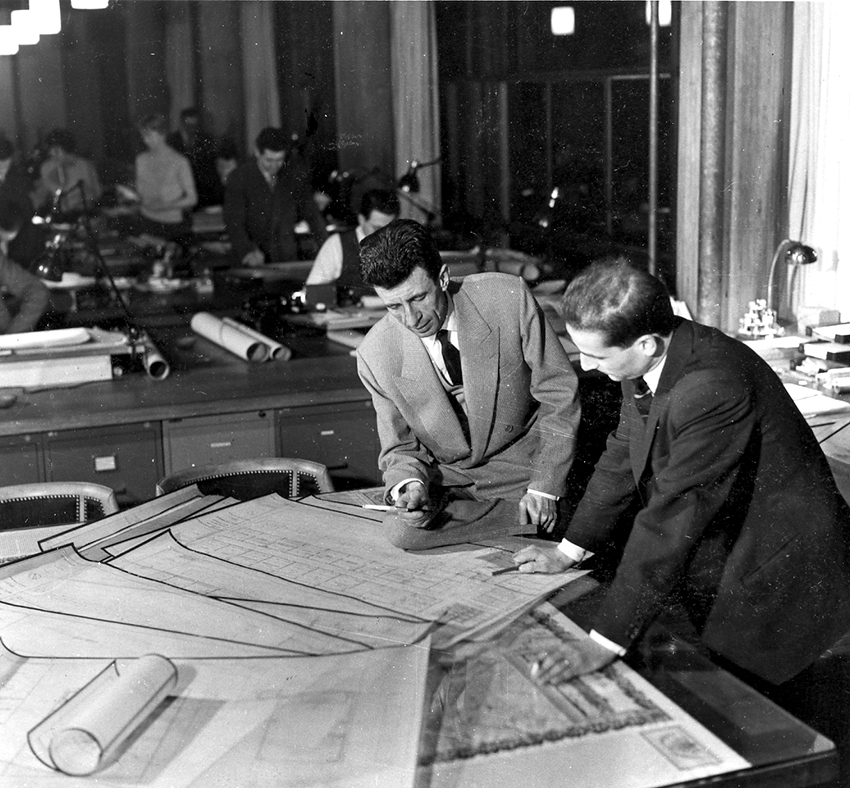life

Fernand Pouillon in his studio in the Rue Raynouard in Paris. PSB Archives.
Fernand Pouillon was born in Cancon (Lot-et-Garonne) on May 14th, 1912. He spent his childhood in Marseille. His professional career began in Provence, where the basis of his notoriety was laid. He built his first building at the age of twenty-two.
His personal style began to emerge in the municipal stadium of Aix-en-Provence (1946) and in the Marseille health station (1947): a type of modernity closely related to the history of architecture and engineering, the re-use of traditional construction methods, the enhancement of each material through the masterful combination of the constructive elements, and the adequacy of form to use. Throughout his life he proved to be sensitive to the use of any construction method, and to the use of materials and forms useful to the achievement of his goals at the service of architecture and of his fellow men.
The La Tourette complex in Marseille is the decisive confirmation of all his thinking. The development of a design method to control his designs culminated in Les 200 logements complex in Aix-en-Provence, where he achieved extremely rapid construction times and incredibly low costs. The thousands of apartments built in Algiers between 1954 and 1958 – Diar-es-Saada, Diar-el-Mahçoul and Climat de France – followed. In the same period Pouillon built various buildings in Iran: two railway stations, the Iranian Empire Headquarters, the National Geographical Institute and presumably some military districts.
In the projects for Pantin, Montrouge, Meudon-la-Forêt, and Boulogne-Billancourt (1957-1961), located in the Parisian belt, he played the roles of entrepreneur, architect and client simultaneously. These large-scale real estate promotion projects benefited from the support of prominent political figures, some of whom would later be among the main people responsible for his downfall. In 1961, he was the main defendant in the judicial proceedings concerning the 2260 apartments of the Point du Jour complex in Boulogne-Billancourt. Deprived of liberty until 1964, Fernand Pouillon devoted himself to writing Les pierres sauvages, the construction diary of the abbey of Le Thoronet (12th century) in the Var region, which received the Prix des Deux Magots in 1965 and is still a literary success today, as well as Mémoires d’un architecte (1968).
Despite the life expulsion from the French Order of Architects, in 1965 Fernand Pouillon began working on the plan for the new city of Créteil (a suburb of Paris), with the consent of the French presidency. At the same time, he worked on a tourism development programme for Algeria with his friend Jacques Chevallier, the former mayor of Algiers. After abandoning the Créteil project, he decided to invest all his energy in Algeria.
Until 1984, the year of his definitive return, Fernand Pouillon built only occasionally in France: a complex of 450 single-family houses in Ozoir-la-Ferrière, a building in Reims, the restoration of Belcastel (a medieval stronghold in Aveyron), an abbey in Cotignac, some private villas and the Metallic Structure Houses, for which he developed the project, manufacture and marketing for P.U.M, a metallurgical production industry.
President Houari Boumédiène’s Algeria was a forerunner of tourist programmes in the Mediterranean and offered him an immense territory, in which architecture was adapted each time to the geographical context, to the men for whom it was intended, and to the uses it was designed for. The works built in independent Algeria may be confusing because of their composite character. The most emblematic achievements are the tourist complexes of Sidi Ferruch and Tipasa, and the hotels of Ghardaïa, Timimoun and Seraïdi. Later on it was above all the Ministry of Higher Education that entrusted him with projects for various university campuses. His last major endeavour in Algeria was the enlargement of the Hôtel El-Djazaïr (formerly named Hôtel Saint-George), completed in 1982.
President Georges Pompidou’s France granted him an amnesty in 1971 and the Order of Architects reintegrated him in 1978. He was elected in the Council of the Order in 1980 and 1986. Since 1984, President François Mitterrand fostered his return to France, awarding him the Légion d’Honneur and entrusting him with the project for an international conference centre on the Quai Branly riverfront in Paris, where the Musée du quai Branly is located today.
Fernand Pouillon travelled the whole world, from Iran to South Africa, from Japan to Australia, from Peru to Martinique, from the Ivory Coast to Abu Dhabi, from the United States to Puerto Rico, on journeys in which his interest for business merged with deep attention to the different cultures of men and landscapes. In the 1950s, he offered his young collaborators two study periods in Italy and Spain, encouraging them to draw and take photographs. In his opinion, knowledge of the arts and civilizations was indispensable to architectural culture. To this end, in the 1970s he founded a publishing house, the Jardin de Flore, to republish thirty-three extremely rare major works, such as the first treatise on perspective by Viator (Venice: 1505) or the Divina Proportione by Luca Pacioli (Venice: 1509).
The life of Fernand Pouillon was a permanent and unreserved commitment to a more beautiful, more fraternal, and more authentic world through architecture. Its relationship to the happiness of people takes on a prominent position in his vision of the social responsibilities of the architect. He died on July 24th, 1986. He fought his last battle, just after being elected in the Council of the Order of Architects, as the head of a list he named “For the Architectural Landscape of France”.